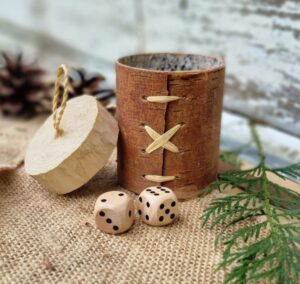Looking for a hygge game to play with all the family? Well, hands-down Mia is our favourite game to play on holiday, in the pub or while waiting for a plane! You can find our wooden Mia gift set here (which comes with full instructions) or carry on reading for the lowdown along with a free PDF to print out and keep 🙂
For 2 to 6+ players
This is a game which seems complicated, but is incredibly good fun, based as it is on bluffing and lying to your friends. Medieval re-enactors particularly enjoy this game around a campfire, when they’ve spent the evening doing the best part of a bottle of mead and reliving their finest bruises. Supposedly it originates from Viking times, with both mentions of dice games in the Icelandic sagas (taflkast), and frequent finds of dice in pairs in the archaeological record.
You will need two playing dice, an opaque dice cup or beaker with a lid and a life dice (or 6 matchsticks) for each player to record how many lives they’ve lost; please feel free to download the instruction to print at home here How to play Viking liar dice (mire. mia, meier) or if you are looking for a hygge dice game to play with friends or kids, check out our instructions on how to play the Danish dice game “greedy“.
How to Start
Each player starts with six lives, so everyone turns their life dice so six pips face up.
The initial play
Player One rolls the two playing dice in the cup, has a discreet look, and then makes a decision based on the following three choices…
- Tell the truth and say what he has just rolled
- Lie and either announce a greater value than the one he has actually rolled
- Lie and announce a lesser value (useful if there aren’t many players and there is a good chance play will come around to him again).
The next turn
The dice are concealed with the lid or hand and carefully passed to Player Two, who now also has three options.
- Believe Player One, in which case he has to roll either the same or higher, without looking at Player One’s dice. At this point he can roll, take a look and then make his offer; if however he has rolled lower and doesn’t think he can lie successfully, he can make one more roll with the pot covered and then pass it on blind.
- Call Player One a liar, and look at the dice to see if he was right. If the dice was lower than Player One announced, Player One loses a life. However if it was equal or higher, then Player Two loses a life.
- Pass the dice to the next player without looking. This relieves Player One of all responsibility, and the bluff is now on Player Two’s shoulders.
Continuing play
Player Three can now follow the same three options; either calling out the pass, believing it and rolling to beat it, or passing it straight on. Each player must always match or beat the previous value, or pass it on blind and take his chances.
If the game continues all the way round the circle back to Player One, then he cannot continue without raising the score. When a player loses a life he must either lose a matchstick or turn his life dice up to show one less pip. The play then returns to the player who preceded him.
Scoring
The numbers made of mixed dice come lowest, with the highest number always coming first, e.g., 31, 54, 63 etc.
Next come the doubles, running from a low of 11 up to the highest 66.
Highest of all is Mia, or 21; nothing can beat this except another Mia, and if it is rolled or announced, the losing player forfeits two lives.
So, the complete order of rolls runs like this, from lowest to highest 31,32,41,42,43,51,52,53,54,61,62,63,64,65,11,22,33,44,55,66,21.
Strategy
This is much easier to play than it sounds; just remember that you must either trust, or match and beat the player who came before you. And if you can’t, lie, lie, lie!
Often the player who follows you won’t want to risk losing a life by challenging you incorrectly and so will accept your call at face value. It helps to remember that 62 is a fairly middle-of-the-road score, so you’ve got a good chance of beating that, either on your first roll or using your second blind shot.
If you have a score in the high doubles, sometimes your opponents will gang up on you and carry on passing the pot blind around the circle until it comes back to you as they know you will have to roll higher when it’s your turn. For this reason it is often a good idea to underplay your hand and say it is a lesser roll (particularly if it is a Mia) on the off chance you are going to have to beat it.





